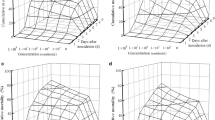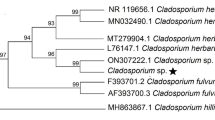Abstract
Naturally, citrus blackfly mycosis nymphs were observed in citrus orchard in the vicinity of Vidarbha region of Maharashtra and the fungus colony recovered on SDA media using tissue isolation technique. The characterization of the morphology involved mycelium, conidia, colony appearance and stroma types; the isolated fungus resulting from molecular recognition was Aschersonia aleyrodis. In vitro investigations were conducted to evaluate the pathogenesis of Aschersonia aleyrodis PDKV isolate against Aleurocanthus woglumi using a topical application method. Early infection of blackfly-by fungus was detected as white fringes of hyphae extending from the marginal area of the nymphal body. At the end of the infection, mat-like pustules were observed to cover the entire nymphal body. At first, colonies were white and became yellowish to orange in colour as stroma form. The effect of eleven chemical fungicides and seven insecticides commonly used in citrus crop was evaluated at half and recommended doses in vitro on the mycelial growth of A. aleyrodis. Maximum radial mycelial growth was achieved in mancozeb i.e. 4.3 cm and 1.8 cm at half and recommended doses, while carbendzaim, fosetyl Al, carbendazim + mancozeb (combi product), and tebuconozol + trifloxystrobin (combi product) completely inhibited the growth of A. aleyrodis at concentrations tested. Among the insecticides, dimethoate notably supported the maximum growth (5.2 cm) of A. aleyrodis over the rest of the insecticides at the concentrations tested. Present work shows that the most suitable insecticides and fungicides in conjunction with A. aleyrodis are to be used in Integrated Pest Management Programs.





Similar content being viewed by others
Availability of data and materials
All data of the study have been presented in the manuscript, and high quality and grade materials were used in this study.
References
Abbott WS (1925) A method of computing the effectiveness of an insecticide. J Econ Ent 18:265–267
Alizadeh A, Samih MA, Khezri M, Riseh RS (2007) Compatibility of Beauveria bassiana (Bals.) Vuill. with several pesticides. Int J Agric Biol 9(1):31–34.1560–8530/2007/09–1–31–34
Amutha M, Banu JG, Surulivelu T, Gopalakrishnan N (2010) Effect of commonly used insecticides on the growth of white muscardine fungus, Beauveria bassiana under laboratory conditions. J Biopestic 3(1 Special Issue):143–146
Anderson TE, Roberts DW (1983) Compatibility of Beauveria bassiana isolate with insecticide formulations used in Colorado Potato Beetle (Coleotera: Crysomelidae) control. J Econ Entomol 76:1437–1441
Berger EW (1921) Natural enemies of scale insects and whiteflies in Florida. Florida Quart Bull Fla Stn Plant Board 5:141
Bhosale DN, Ingle YV, Paithankar DH, Sadawarte AK (2020) Efficacy of Aschersonia aleyrodis against citrus black fly and white fly. Indian J Entomol 82(3):464–466
Challa MM, Sanivada SK (2014) Compatibility of Beauveria bassiana (Bals.) Vuill. isolates with selected insecticides and fungicides at agricultural spray tank dose. Innovare J Agric Sci 2(3):7–10
Debnath S (2016) Studies on entomopathogenic fungus Aschersoniaaleyrodis infectious to scale insect pest, Saisettia formicarii of tea, Camellia sinensis (l). O. Kuntze in Assam. Indian J Fundam Appl Life Sci 6(3):14–24. http://www.cibtech.org/jls.htm
Fasulo TR, Weems HV (1999) Citrus whitefly, Dialeurodes citri (Ashmead) (Insecta: Hemiptera: Aleyrodidae). IFAS Extension Bulletin, University of Florida 1–6
Fransen JJ, van Lenteren JC (1994) Survival of the parasitoid Encarsia formosa after treatment of parasitized greenhouse whitefly larvae with fungal spores of Aschersonia aleyrodis. Entomol Exp Appl 71:235–243
Hall TA (1999) BioEdit: A user-friendly biological sequence alignment editor and analysis program for Windows 95/98/NT. Nucleic Acids Symp Ser 41:95–98. https://doi.org/10.14601/Phytopathol_Mediterr-14998u1.29
Hassan SA (1989) Testing methodology and the concept of the IOBC/WPRS working group. In Pesticides and Non-Target Invertebrates (P.C.Jepson, ed.), Intercept,Wimborne, Dorset 1–8
Ingle YV, Bhosale DN, Paithankar DH, Mane SS, Lande GK (2019) Natural occurrence of Aschersonia aleyrodis on citrus black fly in Vidarbha region of Maharashtra. J Plant Dis Sci 14(2):147–150
Lima BF, Marcondes JE, de Almeida J, Moreira OT, Coelho L, dos Santos M, Bittencourt AL (2017) Entomopathogenic fungi associated with citrus blackfly (Aleurocanthus woglumi Ashby) in Southern Bahia. Agric Entomol Sci Commun. https://doi.org/10.1590/1808-1657000102015
Liu M, Chaverri P, Hodge KT (2006) A taxonomic revision of the insect biocontrol fungus Aschersonia aleyrodis, its allies with white stroma and their Hypocrella sexual states. Mycol Res 10:537–554
Meekes ETM, van Voorst S, Joosten NN, Fransen JJ, van Lenteren JC (2000) Persistence of the fungal whitefly pathogen Aschersonia aleyrodis, on three different plant species. Mycol Res 104(10):1234–1240
Meekes ETM, Joanne JF, Joop CL (2002) Pathogenicity of Aschersonia spp. against whiteflies Bemisia argentifolii and Trialeurodes vaporariorum. J Invert Path 81:1111
McCoy CW, Samson RA, Boucias DG (1997) Entomogenous fungi. In Ignoffo CM, Mandava NB (eds) CRC Handbook of Natural Pesticides. CRC Press, Boca Raton 151–236
Mongkolsamrit S, Luangsa Ard JJ, Spatafora JW, Sung GH, Hywel JNL (2009) A combined ITS rDNA and beta-tubulin phylogeny of Thai species of Hypocrella with non-fragmenting ascospores. Mycol Res 113:684–699
Mongkolsamrit S, Khonsanit A, Noisripoom W, Baldorj P (2014) Aschersonia narathiwatensis sp. nov. from southern Thailand. J Nat Prod 129(1):33–40
Murray MG, Thompson WF (1980) Rapid isolation of high molecular weight DNA. Nucleic Acid Res 8:4321–4325
Nene YL, Thapliyal PN (1987) Fungicides in plant disease control, 2nd edn. Oxford & IBH Publishing, New Delhi, pp 531–532
Pena MR, Silva NM, Bentes JLS, Alives SB, Bezerra EJS, Vendramin JD, Lourencao AL, Humber RA (2009) Occurance of entomopathogenic fungi from agriculture and natural ecosystem. Arg Inst Biot Ins Sci 76(4):619–625
Prasad TSK, Kumar A, Bhat DJ (2004) New records of Aschersonia from forest of Western Ghtas, India. J Mycol Pl Pathol 34(1):7–14
Quintela ED, McCoy CW (1998) Synergistic effect of imidacloprid and two entomopathogenic fungi on the behavior and survival of larvae of Diaprepes abbreviatus (Coleoptera: Curculionidae) in soil. J Econ Entomol 91:110–122
Qiu J, Li GX, Qiu XY, Song F (2013) Optimization of the medium composition of a biphasic production system for mycelial growth and spore production of Aschersonia placenta using response surface methodology. J Invert Path 112:108–115
Roberts DW, Campbell AS (1977) Stability of Entomopathogenic Fungi. Misc Publ Entomol Soc Amer 10(3):19–76
Samson RA, Evan HC, Latge JP (1988) Atlas of entomopathogenic fungi. Springer-Verlag, Amsterdam, TheNetherlands
Sikder Md, Mallik MRI, M, Nuhu Alam, (2019) Identification and in vitro growth characteristics of entomopathogenic fungus-Aschersonia sp. in Bangladesh. Adv Zool Bot 7(1):11–18
Shivankar VJ (1999) Insect pests of citrus and their management. Citriculture, (Ed) Shyamsingh Kalyani Publication 241–256
Sudiarta, IP, Suputra, IPW, Wirya, GNAS (2019) New report of insect pathogenic fungi (Aschersonia sp.) of citrus whitefly (Dialeurodes sp.) in Bali, Indonesia. Res Agric Vet Sci 3(1):22–27
Uchida M (1970) Studies on the use of the parasitic fungus Aschersonia spp. for controlling citrus white fly, Dialeurodes citri. Bull Kanagawa Hortic Exp Stn 18:66–74
Vincent JM (1927) Distortation of fungal hyphae in presence of certain inhibitors. Nature 15:850
White TJ, Bruns T, Lee S, Taylor JW (1990) Amplification and direct sequencing of fungal ribosomal RNA genes for phylogenetics. In: Innis MA, Gelfand DH, Sninsky JJ, White TJ (eds) PCR protocols: A guide to methods and applications. Academic Press, Inc., New York, pp 315–322
Wirya GNAS, Suputra IPW, Sudiarta IP (2016) Morphological identification and infection percentage in field of insect pathogen fungi Aschersonia sp. that infected citrus whitefly (Dialeurodes citri Ashmed) on citrus. Proc Semin Natl Perhortidan Pragi 114
Zhang C, Ali S, Musa PD, Wang XM, Qiu BL (2017) Evaluation of the pathogenicity of Aschersonia aleyrodis on Bemicia tabaci in the laboratory and greenhouse. Biocontrol Sci and Tech 27(2):210–221
Acknowledgements
All sort of assistance rendered by ICAR-AICRP on Fruits scheme for the above study is gratefully acknowledged.
Funding
The study was conducted with the available laboratory resources without any aid from any funding agency.
Author information
Authors and Affiliations
Contributions
YI designed, supervised the work and approved the final manuscript, DB and VK conducted the study and analyzed the parameters data.SB, SM, DP and AS contributed in paper writing. All authors have read and approved the final manuscript.
Corresponding author
Ethics declarations
Consent for publication
All authors are agreed to publish this paper.
Conflict of interest
The authors declare that they have no conflict of interest.
Additional information
Publisher's note
Springer Nature remains neutral with regard to jurisdictional claims in published maps and institutional affiliations.
Rights and permissions
About this article
Cite this article
Ingle, Y.V., Bhosale, D.N., Karande, V.D. et al. Identification, pathogenesis and compatibility of Aschersonia aleyrodis (Webber) with selected fungicides and insecticides. Int J Trop Insect Sci 42, 2093–2101 (2022). https://doi.org/10.1007/s42690-022-00730-9
Received:
Accepted:
Published:
Issue Date:
DOI: https://doi.org/10.1007/s42690-022-00730-9




